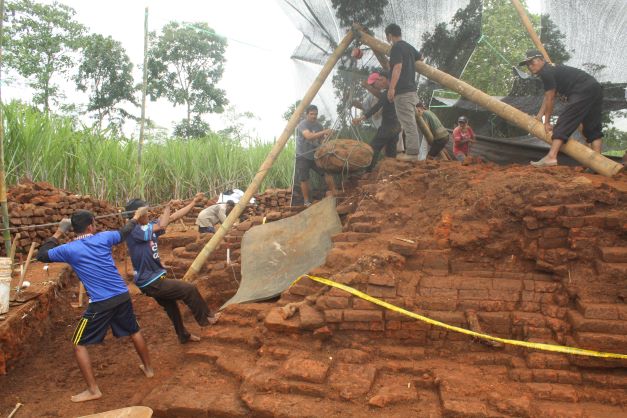To the Europeans and before them the Arabs and Indians, the lure of the archipelago was resources and trade.
That’s still the case as exports of coal, gold, and minerals needed in batteries and electronics are powering the Republic’s economy ahead of its neighbours.
But the islands have something else that can’t be tipped into barges and stuffed into containers, yet precious beyond mountains of dollars. History, and at last we’re becoming aware of the riches.
With no names and few facts, we’ll have to construct a story – which is what archaeologists are doing all the time, like detectives on a cold case. Let’s call him Agus, the unknown hero. Late last decade he was working on the Malang end of the toll road linking the Central East Java hilltown with the provincial north-coast capital Surabaya.
Maybe it was a slack day, or the crews were waiting for more concrete. Perhaps he needed to relieve himself so wandered into the scrub where he noticed a red brick. So what? Despite forests of signs warning locals not to dump rubbish, rivers, and uncropped land are popular tips, so building rubble would be nothing unusual. Except this brick was much larger than the standard, and Agus was blessed with that most desirable but underrated quality – curiosity. He picked up the brick, found others, and spoke out – and now we know of another temple site. How old, how big, what name – there are more questions with the answers depending on funds for excavation.
In the nearby hamlet of Srigading, workers on another site are being paid by a local businessman who was told of a mound in the centre of a flat field of sugarcane. The villagers called it Cegumuk – meaning something stuck in the throat, so maybe someone once heard a noise. It was just a nuisance. Then a wise one reasoned the rise might not be a geological feature. They were right.
Now it’s a government excavation that’s already yielded artefacts from a thousand years ago, Java’s golden age. Literally, the top of an urn made from yellow metal has already been discovered. The site is most likely a temple from the late Mataram period, the Hindu–Buddhist kingdom that ruled much of Central and East Java between the 8th and 11th centuries.
Archaeologist and dig supervisor Wicaksono Dwi Nugroho said, ‘‘Under the topsoil was a large linga and yoni carved from a rock which isn’t found around here.” He thinks the red-brick temple probably stood 11 metres high and covered a ten-by-ten-metre base. “Moving the yoni aside revealed a shaft about three by three metres. So far we’ve retrieved three statues, some clay pots, and a broken ceramic plate which was probably traded from China.”
A yoni represents the goddess Shakti, the linga its masculine counterpart. The Encyclopaedia of Hinduism defines the icons as “the union of the feminine and the masculine that recreates all of existence”. Although Srigading is largely Muslim, the yoni has been sprinkled with blossom and wrapped in white cloth.
Opening the mound has led to supernatural sightings. Locals told one reporter of “strange events” near the temple and a “large black man towering up to more than two meters…sitting cross-legged on the rock like a ‘guardian’.”
The Hindu kingdoms collapsed in the 16th century. The reasons are contested – the spread of Islam, breakups in the ruling families, power shifts or volcanic eruptions. The survivors fled east and mainly settled in Bali which remains Indonesia’s only Hindu province. The holy places were abandoned, plundered by treasure seekers and builders seeking bricks. Jungle creepers soon masked the remains.
For much of the 350 years of colonialism, the Dutch were more interested in guilder than curiosities. But between 1811 and 1814, Thomas Stamford Raffles was the Lieutenant-Governor of Java following the Napoleonic Wars. A refined Englishman who spoke Malay, Raffles was bewitched by the traditions and masterpieces of architecture and engineering the Dutch had ignored. His 1817 The History of Java, describes the story of the island from ancient times plus its mores, arts, beliefs, geography, flora, and fauna. It’s available online.
When the Dutch regained control, they started recording sites and shipped statues to Leiden where many still await repatriation. After the 1945 Declaration of Independence, the preservation of the new nation was more important than conserving history. Now a younger generation is recognising the earlier centuries and venerating pre-colonial heroes, like Majapahit era prime minister Gajah Mada (1290-1364). One of the nation’s most prestigious universities carries his name.
The early kingdoms are becoming the foundations for Indonesian nationalism, according to Indonesian historian Dr Wayan Jarrah Sastrawan, “Faced with the diversity of languages, customs, and religions in the archipelago, leaders…turned to the pre-modern past to find powerful states (as) precursors of modern Indonesia.” They chose Majapahit.
The palm-leaf manuscript Nagarakretagama, written in 1365 claims Majapahit had 98 tributary states from Sumatra in the west to New Guinea and included Singapore, Malaysia, Brunei, southern Thailand, and the Philippines’ Sulu Archipelago.
Once taught that everything started in 1945, we’re now learning that Dutch colonialism was but a hiccup. Or Cegumuk.




